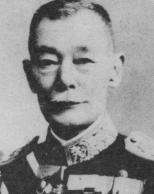Yamashita Gentarō
| Baron Yamashita Gentarō | |
|---|---|
|
Japanese Admiral Yamashita Gentarō | |
| Native name | 山下 源太郎 |
| Born |
July 30, 1863 Yonezawa, Dewa Province, Japan |
| Died |
February 18, 1931 (aged 67)[1] Japan |
| Allegiance | Empire of Japan |
| Service/branch |
|
| Years of service | 1879–1928 |
| Rank | Admiral |
| Commands held |
|
| Battles/wars | |
| Awards | Order of the Golden Kite (3rd class) |
Baron Yamashita Gentarō (山下 源太郎, 30 July 1863 – 18 February 1931) was an admiral in the early Imperial Japanese Navy.
Biography
Born in the Yonezawa Domain, Dewa Province (present day Yamagata prefecture), Yamashita graduated from the 10th class of the Imperial Japanese Naval Academy in 1883, ranked 4th out of 27 cadets. After midshipman service in the ironclad warship Ryūjō and the cruiser Asama, he was assigned to a number of ships in the early navy, including the corvette Jingei, the ironclad warship Fusō, the corvette Kaimon, the gunboat Atago, and the cruiser Takachiho.[1] He then received advanced naval artillery training, and was assigned to the corvette Hiei as the chief gunnery officer in 1891, followed by assignments on Kaimon and the corvette Musashi.[1]
During the First Sino-Japanese War, Yamashita served as the chief gunnery officer on the corvette Kongō, followed by the Akitsushima. At the end of the war, Yamashita had a number of administrative assignments ashore.
In 1896, Yamashita was assigned to England to oversee warship construction.[2] While based in London, he was promoted to lieutenant commander in 1897 and then to commander in 1898. On his return to Japan in 1899, he was appointed executive officer, first on the cruiser Izumi, then on the Kasuga.[1]
In July 1900, Yamashita was assigned command of Japanese marines during the Boxer Rebellion at Tientsin[2] and, after performing special duty in Hong Kong and Chefoo, he was promoted to captain in 1903.
During the Russo-Japanese War, Yamashita served as an operations planner at the Imperial Japanese Navy General Staff.[2] Following the war, he was assigned command of the cruiser Iwate, which proved to be the only time he ever captained a ship. After holding various staff posts between 1906 and 1912, Yamashita was promoted to rear admiral on 28 August 1908 and vice admiral on 1 December 1912. From 1910 to 1914, he was the Commandant of the Imperial Japanese Naval Academy.
Following Japan's entry into World War I, Yamashita served as vice chief of the Navy General Staff until 1915. From 1915 to 1917, he was the Commander in Chief of the Sasebo Naval District. On 1 December 1917, he was given command of the IJN 1st Fleet. Promoted to admiral on 2 July 1918, Yamashita served as commander of the Combined Fleet from 1 September 1918 until 28 October 1918, shortly before the war's end.[1]
After serving as Chief of the Imperial Japanese Navy General Staff from 1 December 1920 until 15 April 1925, Yamashita held several honorary and ceremonial posts until being placed on the second reserve list on 1 July 1928. He was ennobled with the title of danshaku (baron) under the kazoku peerage system on 10 November 1928,[1] and lived in retirement until his death in 1931. His grave is at the Aoyama Cemetery in Tokyo.
References
- Agawa, Hiroyuki (2000). The Reluctant Admiral: Yamamoto and the Imperial Navy. Kodansha International. ISBN 4-7700-2539-4.
- Dupuy, Trevor N. (1992). Encyclopedia of Military Biography. I B Tauris & Co Ltd. ISBN 1-85043-569-3.
- Kowner, Rotem (2006). Historical Dictionary of the Russo-Japanese War. The Scarecrow Press. ISBN 0-8108-4927-5.
External links
- Nishida, Hiroshi. "Materials of IJN: Yamashita, Gentaro". Imperial Japanese Navy. Retrieved 2007-08-03.
| Military offices | ||
|---|---|---|
| Preceded by Shimamura Hayao |
Chief of the Imperial Japanese Navy General Staff 1 December 1920 – 15 April 1925 |
Succeeded by Suzuki Kantarō |
